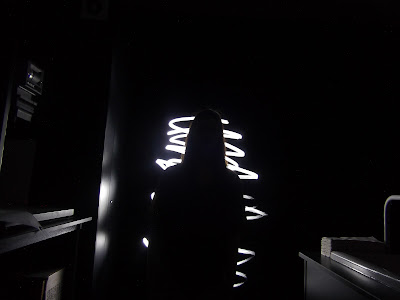Experimenting in the darkroom with a 14 mega pixel digital camera, maximum shutter speed 5 seconds so our drawings were done very quickly, we experimented with a normal torch, then laying the light with orange, yellow or purple tissue paper. We even tried using 2 torches at once to experiment with different colours, drawing circles, stars, random squiggles, letters and creating sillohettes by me drawing around a friend in front of me in the dark, whilst another friend operates the camera. here are the light drawings which I drew myself. Also shining lights onto my face and hands and moving them whilst turning the torch on and off to create eery dark effects.
Using a torch I drew as fast as I could in a zig zag motion around her silohette to create a ghostly appearance in the darkness, my friend stood infront of me the camera on a tripod infront of her whilst my other friend started the shutter speed when I started to draw. More light needed around her silohette for this one...
My second attempt at the same effect, more lines make it work better, the surfaces captured in the background add to the erriness of a figure like that being in a normal place, when cropped out the spacial effect was taken away (below).
Above are the same photographs although I edited the surfaces out using the clone tool on photoshop.
Using yellow tissure paper over the torch light this colour was created, the first one was random shapes but has a sort of cubist/surrealist effect in terms of the shapes created related to actual paintings by Picasso, the second a simple letter L for my name.
Using two torches, we put tissue paper over them, one orange and one purple for a different coloured line created, my first try was random scribbles as shown above.
Same method as the last one, this time drawing stars with both of the torches. The second one worked best because my aim worked well.
This time swirls created, because they look symetrical almost I like their cold colours with the warm yellow.
Figures of 8 overlapping eachother with the same method as before.
This time I draw one star with the torches following the same path, shades of turqoise were created somehow with the purple here which I like. Although the shape didn't turn out well here so the one below is my second attempt.
Using the torch by itself below to create a circle, boring, too simple compared to my other ones.
Below the circle was more circular in my second attempt.
For my third attempt I tried to draw more circles around the same one but this didn't work too well and insted I ended up with lines.
Below my attempt to draw a basic flower created some very direct light flashes onto the lens (white light from the torch).
Below I aimed the torch at my hand rather than directly at the camera so that they would be captured and not the torch light, I turned the torch on for one hand, off as I moved my hand to another place and on again so that no paths were created during the movement, just the hands. The darkness around them makes its scary, their bluriness adds to movement of the picture and makes it seem as if someone is trapped or scared in a horror movie.
Below I did the same thing but with my face, I aimed the torch upwards towards it to capture it, then off and on again when I had changed position, the whole of the process of these photographs had to be done rather quickly because of the 5 second shutter speed.
Below I went back to the silohette idea I did earlier on and tried circular shapes instead and tried to really bring out the silohette more, the mood of these ones is much more positive rather than eerie. Light reflected on the wall also creates depth.
This one below worked really well because of the slight appearance of his face, the expression is positive adding to the excitement of the picture and wild lines around.
Below I covered the area where I would usually be drawing with the torch all around her with a curtain so that my drawing would only be seen on the left side, this added light to her clothing as if I was painting her with the light rather than just the background, her pose onto the certain was inspired by Patrcik Rochon's fashion shoots (Supernovae) involving various light painting of female models.
Same method below but I tried for a less blurry effect, it worked and I somehow got a beam of light firing across her face which worked well and look different to my others, my favourite one produced by me.
Below the light was brighter because we were just outside of the darkroon rather than inside like the rest, so I tried the silohette effect again with her features slightly on show, the light reflects off of the wall too looking almost like an explosion or landing of her.
Below I cropped out the right side showing the curtain and light so that the picture was fully focused of her and the light around.
A favourite below, 2 friends in an attacking pose, white light created by the torch, red created by a red laser pen to present his evil side towards attacking her, I chose this pose to relate to the horror theme of my earlier silohettes.




























































